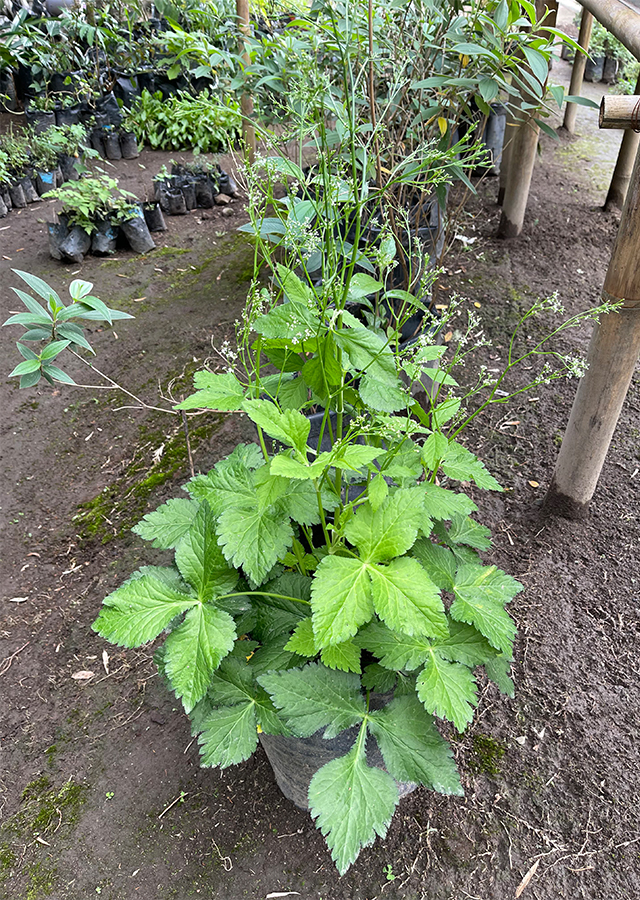Japanese Parsley
Cryptotaenia japonica Hassk.
Apiaceae
Location in our garden
Principal



Synonym
Cryptotaenia canadensis f. atropurpurea (Makino) Yonek.
Cryptotaenia canadensis f. warabiana (Makino) Yonek.
Deringa dissecta (Y.Yabe) Koso-Pol.
Habitus
Herbaceous. An evergreen perennial plant growing up to 100 cm tall
Part Used
Roots
The Whole Plant
Growing Requirements
Need Shade
Habitat
Forest
Mountains
Overview
Cryptotaenia japonica or Mitsuba is a species native to East Asia (China, Korea, and Japan). Records say that Mitsuba was cultivated in Japan since the seventeenth century, but is still often harvested from the wild. This species later spread from Asia to most of the world, because of its ease of propagation. Mitsuba is a plant recognized in the culinary world as one of Japan's traditional healthy vegetables, it is also commonly used and highly respected in many parts of China, Korea and Taiwan. Japanese people believe that the aroma of Mitsuba can stimulate the appetite, so since ancient times, the leaves and stems are widely used in various Japanese cuisines. The seeds can also be used as a spice in the manufacture of cakes, biscuits, bread or other food dishes. Mitsuba is a good source of protein, vitamin K and other variety of vitamins and minerals that are very beneficial for the body's metabolism, low in saturated fat and very low in cholesterol. Apart from being a vegetable and flavoring, mitsuba has a long tradition of its use as traditional medicine in China, Japan, Korea, and Taiwan.
Vernacular Names
Mitsuba (Japanese)
Agroecology
Mitsuba is usually found growing in forests in hills and mountains, with a slope of 30-45°, at an altitude of about 200-2400 m above sea level. Thrives in most soils, including rocky and loamy soils and prefers rich, moist composted soil. This species also likes a shady and damp position under trees. The leaves tend to turn yellow when the plant is grown in full sun.
Morphology
- Roots - thick, strong and long.
- Stems - long, striated, green.
- Leaves - three separate blades, leaf blade rhombus, lateral leaflet obliquely oblong-ovate to ovate, leaf base pointed (cuneate), leaf tip pointed (acuminate), leaf margins appear serrated irregularly, green, pinnate venation, with 4 -6 secondary veins dichotomously branch at the apex. Bracts absent or 1, linear. Has a distinctive and strong aroma, at first glance similar to parsley leaves.
- Flowers - white, small and clustered. The sepals (petals) are 5, up to 1 mm long, triangular in shape. Petals are 5, up to 1.5 mm long, elliptical, white, flowers in full bloom. Stamens are 5, inserted, ovary (ovary) 2-carpela, cylindrical. The pistil (styles) is long and erect. Terminal inflorescence, in the form of a cymose (additional umbrella).
- Fruits - capsule, oval with five elongated ribs, green.
- Seeds - about 120-180 seeds per plant, dark brown.
Cultivation
Propagated by seeds - sow mid spring in a greenhouse. Germination is usually rapid, prick out the seedlings into individual pots when they are large enough to handle and plant them out in early summer. The ideal temperature for sowing is about 25°c, though seed does germinate at higher and lower temperatures.
Chemical Constituents
Phenolic compounds (luteolin, apigenin and p-coumaric acid are the main compounds), falcarinol and falcarindiol compounds, liquiritin, -hydroxy acid, salicylic acid, linoleic acid, retital acid, cryptotaenen, kiganen, kiganol, petroselic acid, vanillic acid, acid chlorogenic, pentadecanoic acid, 3-O-feruloylquinic acid, kaempferol-7-O-β-d-glucuronide (K7G), acacetin-7-O-β-d-glucuronide, apigetrin, acacetin, diosmetin, naringenin, wogoniside, isomesityl oxide, mesityl oxide, methyl isobutyl ketone, genistein, tilianin, phytol, beta-sitosterol. Also contains essential oils which are dominated by several sesquiterpene constituents, including cuparene, alpha- and beta-selineine, germacrene D, trans-farnesene, beta-elemene and eremophilene, also contains monoterpenes (beta-myrcene, beta-pinene, a-pinene, camphene, p-pinene, sabinene, myrcene, and limonene).
Traditional Medicinal Uses
- Used in the treatment of haemorrhages, colds, fevers etc.
- Used as a tonic for strengthening the body.
- Help lower cholesterol, inhibit cancer growth and ward off free radicals.
- Brighten skin tone.
- Prevent and treat inflammation.
- Treat bleeding.
- Eliminate swelling and help eliminate phlegm.
- A cure for kidney and urinary tract diseases (stones and urinary tract).
- Helps with colds, fevers, colds, coughs, diarrhea, meningitis, rheumatism, menstrual pain, toothache due to colds, herpes zoster, itchy skin and trauma injuries, and is also used as a female aphrodisiac.
- Has activity as an antioxidant, anti-inflammatory, antibacterial, and anti-obesity.
Part Used
Reference Sources
- Royal Botanic Gardens. Plants of the World Online. Cryptotaenia japonica Hassk. https://powo.science.kew.org/taxon/urn:lsid:ipni.org:names:840846-1. 29-05-22.
- Temperate Plants Database, Ken Fern. 2021. Cryptotaenia japonica. http://temperate.theferns.info/plant/Cryptotaenia+japonica. 29-05-22.
- Herbs from Distant Lands. 2020. Cryptotaenia japonica - Mitsuba, Japanese Parsley. http://herbsfromdistantlands.blogspot.com/2020/04/cryptotaenia-japonica-mitsuba-japanese.html?m=1. 29-05-22.
- Zuh-Kyung Seong, Sung-Yoon Lee, Amrit Poudel, Sei Ryang Oh, Hyeong-Kyu Lee. 2016. Constituents of Cryptotaenia japonica Inhibit Melanogenesis via CREB- and MAPK-Associated Signaling Pathways in Murine B16 Melanoma Cells. Molecules, 21(10): 1296. https://www.ncbi.nlm.nih.gov/pmc/articles/PMC6273111/. 29-05-22.
- Andrés Fonseca-Cortés, Jairo A. Peña-Torres. 2021. FIRST RECORD OF THE GENUS CRYPTOTAENIA (APIACEAE, OENANTHEAE) IN COLOMBIA. DARWINIANA, nueva serie 9(1): 63-71. DOI: 10.14522/darwiniana.2021.91.942.

